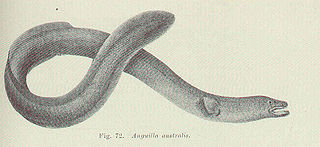
The short-finned eel, also known as the shortfin eel, is one of the 15 species of eel in the family Anguillidae. It is native to the lakes, dams and coastal rivers of south-eastern Australia, New Zealand, and much of the South Pacific, including New Caledonia, Norfolk Island, Lord Howe Island, Tahiti, and Fiji.
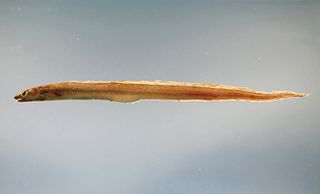
Conger is a genus of marine congrid eels. It includes some of the largest types of eels, ranging up to 2 m (6 ft) or more in length, in the case of the European conger. Large congers have often been observed by divers during the day in parts of the Mediterranean Sea, and both European and American congers are sometimes caught by fishermen along the European and North American Atlantic coasts.

The daggertooth pike conger also known as the darkfin pike eel in Australia, to distinguish it from the related pike-eel, is a species of eel in the pike conger family, Muraenesocidae. They primarily live on soft bottoms in marine and brackish waters down to a depth of 800 m (2,600 ft), but may enter freshwater. They commonly grow to about 1.5 m (4.9 ft) in length, but may grow as long as 2.2 m (7.2 ft). Daggertooth pike congers occur in the Red Sea, on the coast of the northern Indian Ocean, and in the West Pacific from Indochina to Japan. A single specimen was also reported in the Mediterranean Sea off Israel in 1982.

The New Zealand longfin eel, also known as ōrea, is a species of freshwater eel that is endemic to New Zealand. It is the largest freshwater eel in New Zealand and the only endemic species – the other eels found in New Zealand are the native shortfin eel, also found in Australia, and the naturally introduced Australian longfin eel. Longfin eels are long-lived, migrating to the Pacific Ocean near Tonga to breed at the end of their lives. They are good climbers as juveniles and so are found in streams and lakes a long way inland. An important traditional food source for Māori, who name them ōrea, longfin eel numbers are declining and they are classified as endangered, but over one hundred tonnes are still commercially fished each year.

The crested bullhead shark is an uncommon species of bullhead shark, in the family Heterodontidae. It lives off the coast of eastern Australia from the coast to a depth of 93 m (305 ft). This shark can be distinguished from other members of its family by the large size of the ridges above its eyes and by its color pattern of large dark blotches. It typically attains a length of 1.2 m (3.9 ft).

The common skate, also known as the blue skate, is the largest skate in the world, attaining a length of up to 2.85 m. Historically, it was one of the most abundant skates in the northeast Atlantic Ocean and the Mediterranean Sea. Despite its name, today it appears to be absent from much of this range. Where previously abundant, fisheries directly targeted this skate and elsewhere it is caught incidentally as bycatch. The species was uplisted to critically endangered on the IUCN Red List in 2006 and it is protected within the EU.

The European conger is a species of conger of the family Congridae. It is the heaviest eel in the world and native to the northeast Atlantic, including the Mediterranean Sea.
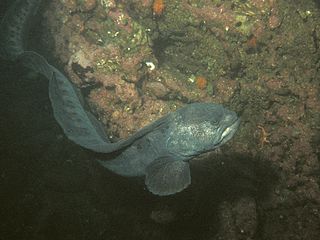
The wolf eel is a species of marine ray-finned fish belonging to the family Anarhichadidae, the wolf fishes. It is found in the North Pacific Ocean. Despite its common name and resemblance, it is not a true eel. It is the only species in the monotypic genus Anarrhichthys.
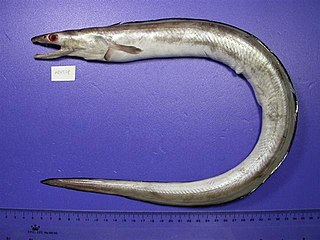
The Muraenesocidae, or pike congers, are a small family of marine eels found worldwide in tropical and subtropical seas. Some species are known to enter brackish water.

Chromis chromis, the damselfish or Mediterranean chromis, is a small species of ray-finned fish of the family Pomacentridae from the Eastern Atlantic and Mediterranean.

Eels are ray-finned fish belonging to the order Anguilliformes, which consists of eight suborders, 20 families, 164 genera, and about 1000 species. Eels undergo considerable development from the early larval stage to the eventual adult stage and are usually predators.

The European pilchard is a species of ray-finned fish in the monotypic genus Sardina. The young of the species are among the many fish that are sometimes called sardines. This common species is found in the northeast Atlantic, the Mediterranean, and the Black Sea at depths of 10–100 m (33–328 ft). It reaches up to 27.5 cm (10.8 in) in length and mostly feeds on planktonic crustaceans. This schooling species is a batch spawner where each female lays 50,000–60,000 eggs.

Muraenesox is a small genus of eels found throughout the Indo-Pacific. It currently has three described species as most species have been moved to other genera. Members are found in the Indo-West Pacific.
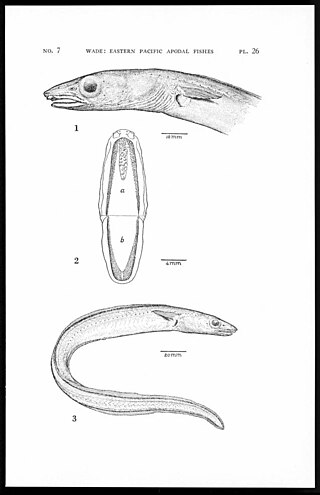
Gnathophis cinctus, the hardtail conger or Catalina conger, is an eel in the family Congridae. It was described by Samuel Garman in 1899, originally under the genus Atopichthys. It is a tropical, marine eel which is known from the eastern central and southeastern Pacific Ocean, including Chile, Colombia, Costa Rica, Ecuador, El Salvador, Guatemala, Honduras, Mexico, Nicaragua, Panama, Peru, and the United States. It dwells at a depth range of 9–336 metres, and leads a benthic lifestyle, burrowing into loose sand. Males can reach a maximum total length of 42 cm.
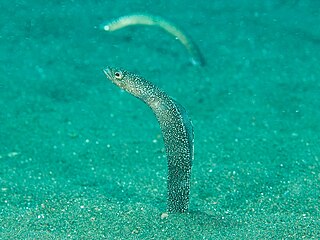
The enigma garden eel is a species of eel in the conger/garden eel family Congridae.

The red pike conger is an eel in the family Muraenesocidae. It was described by David Starr Jordan and Charles Henry Gilbert in 1882, originally under the genus Muraenesox. It is a marine, tropical eel which is known from the eastern central and southeastern Pacific Ocean, including Mexico, Ecuador, Colombia, Costa Rica, Guatemala, El Salvador, Honduras, Panama, Peru, and Nicaragua. It dwells at a depth range of 10 to 100 metres, and inhabits sediments of sand and mud. Males can reach a maximum total length of 202 centimetres (80 in); the maximum recorded weight is 11.0 kilograms (24.3 lb).
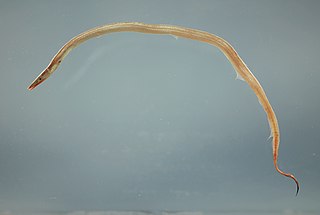
The freckled pike-conger, also known as the silver conger, is an eel in the family Nettastomatidae. It was described by Isaac Ginsburg in 1951. It is a marine, subtropical eel which is known from the western central Atlantic Ocean, including the Gulf of Mexico, Colombia, and towards the mouth of the Amazon River. It dwells at a depth range of 55–310 meters. Males can reach a maximum total length of 54.2 centimeters.

Lutjanus carponotatus, the Spanish flag snapper, stripey snapper, dusky-striped sea-perch, gold-banded sea perch, gold-stripe sea-perch, striped seaperch or stripey seaperch, is a species marine ray-finned fish, a snapper belonging to the family Lutjanidae. It is native to the western Pacific and Indian Oceans, from India to northern Australia.
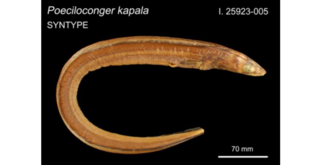
Ariosoma kapala is an eel in the family Congridae. It was first described in 1990 by Peter H. J. Castle as Poeciloconger kapala. The holotype was collected by the New South Wales Fisheries Research Vessel Kapala on April 11, 1985, during a bottom trawl at a depth of 46–64 m. The species was named for the FRV Kapala. In 1998, Shieh-Chieh Shen moved the species to the genus Ariosoma.


















